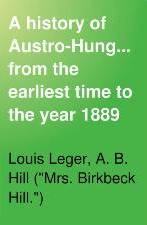TRANSLATOR NOTE:
The following translation, made
from the third edition of the
original work, is not meant for
scholars, who will read what M.
Leger has to say in his own
words, but rather for the
general public, which does not
care to study the history of a
foreign country in a foreign
language. Though pains have been
taken to render the author's
meaning as closely as possible,
it does not pretend to be
literal, and an apology is due
to M. Leger for the omission of
one or two short passages, and
some allusions which seemed
especially meant for his
countrymen.
Had it
been possible for me to read Mr.
Freeman's Preface before I began
my work, I should have tried to
avoid the use of the phrase
"Austrian empire" as a
translation of Petat Autrichien; as
it is, I have used it in the
same way as Englishmen use the
expression " British empire."
Students of Austro-Hungarian
history will find the constant
use of a good atlas a necessity,
and it has therefore not been
thought needful to reproduce M.
Leger's maps—only one, and that
an ethnographical map, being
added to the work.
I am
indebted for the list of books,
and for the note on the
pronunciation of certain letters
in the Slavonic languages, to
Mr. W. R. Morfill, of Oriel
College, Oxford, to whom I wish
here to express my thanks for
the kindness and patience with
which he has helped me
throughout my work, by reading
over the proofs in order to
correct
the spelling of the Slav names.
That, in spite of all his care,
I have allowed errors to remain,
I am only too well aware; but
that is my fault, and does not
lessen my debt to him. My thanks
are also due to Professor W. J.
Ashley, of Toronto University,
Canada, who has read the whole
of the translation, and helped
me in many ways; and last, but
not least, to Mr. Freeman for
his Preface. It only remains for
me to express my regret that M.
Leger has not found a translator
better fitted for the task of
arousing interest in the subject
he has so closely at heart.
THE
TRANSLATOR, Oxford, 1889.





